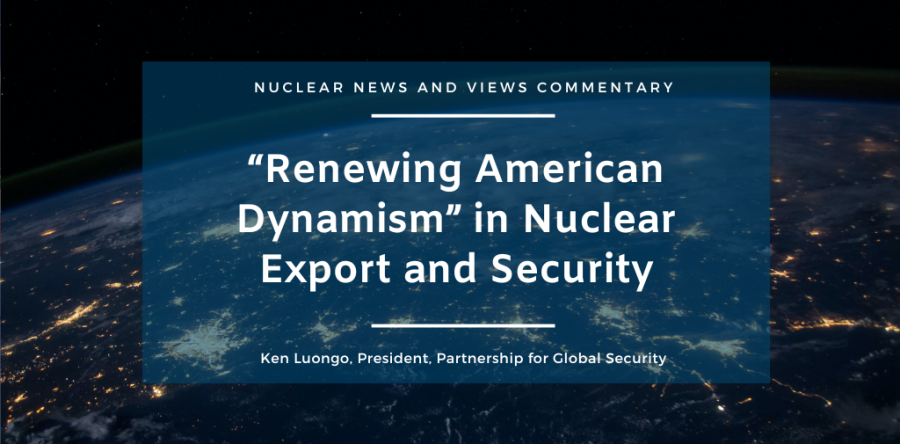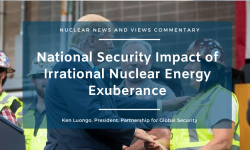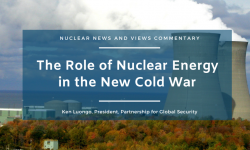A recent RAND report on the sources of American dynamism and decline is very relevant to the country’s desire to lead any civil nuclear resurgence.
At the heart of this desired leadership is the ability of the U.S. to produce competitive nuclear products and packages in an international environment where its challengers from Russia and China have already designed and tested appealing offerings and have cultivated many more potential markets.
The RAND study assesses both internal and external challenges that are creating headwinds to America’s global dominance.
Among the multiple reasons offered for why American influence faces decline are domestic political polarization, bureaucratic sclerosis, a direct challenge from China, and “declining deference to U.S. power from dozens of developing nations”.
This litany of challenges should be a wake-up call for supercharging a sincere but sub-optimal U.S. nuclear energy deployment and export strategy.
Certainly, the current American political system is deeply polarized with little hope that the parties can find common ground anytime soon. But the issue of renewed American nuclear power assertiveness is a rare matter of bipartisan agreement.
The U.S. Congress has provided billions of dollars for current and future nuclear reactors as a means of addressing carbon reduction, competing with Russian and Chinese technology, undergirding the growing desire for global energy security, and supporting the expansion of its strong nuclear governance standards.
Where this congressional consensus will likely fall apart is if the massive investment does not produce reactor deployment and export results at scale. Achieving that objective is uncertain at this time.
This is where bureaucratic sclerosis intersects with decreased dynamism.
There is no doubt that the federal bureaucracy is firmly behind the goal of strengthening America’s nuclear competitiveness. It has been very successful in helping to box out competitors in favor of American technology in friendly nations.
But that success is not enough if the COP28 goal of tripling nuclear power by 2050 is a real goal. Or even if the objective is adding to current nuclear output by one-third.
There are currently 440 operable reactors worldwide producing slightly less than 400,000 megawatts of power. Adding one-third to that total would require roughly another 120-130 new, large reactors.
But there are currently only 60 reactors under construction, the majority of which are in China. And China alone is proposing to build another 150 nuclear plants beyond its current construction.
In this environment it is unclear how existing American and allied nation nuclear technology can expand at a similar pace. The market is nebulous, and next-generation of reactors are lower power than today’s large sized plants, necessitating the deployment of more of them to meet nuclear power growth needs.
These smaller reactors are projected to be less expensive, safer, and more widely deployable for energy and associated power production purposes, such as industrial and AI-driven data center applications.
But aside from military nuclear power, and limited examples from Russia and China, most new, small reactors are still in development, as are their vital governance standards, which Russia and China are keenly trying to dilute.
The U.S. government has been an effective steward of the development of these advanced reactor designs in recent years. But it does not have a strong strategy for how to get them into the field after they have been licensed and demonstrated. It also is not prioritizing the policy framework that will be required to support them over the long term.
This is where the RAND-identified direct challenge from China and the decline in deference to U.S. power in the developing world pose a significant intersecting challenge for American nuclear exports.
China, under the Belt and Road Initiative, has engaged about 140 nations, including virtually all nations in Africa and many in the Middle East and South Asia. Russia has numerous nuclear agreements with developing economy nations, far exceeding those of the U.S.
When assessing where smaller, next-gen reactors could be deployed to replace fossil fuel power and support economic and population growth, these are the critical regions and nations that meet the criteria.
The U.S. has energy outreach in many of these nations, but it does not have the systematic approach to creating markets for its products that China has exhibited under BRI or that Russia has demonstrated in its rapacious signing of nuclear MOUs.
The U.S. also has not deeply thought through how it would finance the export of its next-gen reactors to these small-grid nations or support their long-term safe and secure operation.
Further, if these nations are growing more skeptical of American power, it is a question whether they will they be willing to accept a likely superior U.S. nuclear technology and its higher governance standards when they can get China, or Russia, to favorably finance a small reactor package. This includes operating the plant for them until their staff is trained and possibly accepting the repatriation of the nuclear waste.
These are the challenges that need to be tackled now that the country has made the decision to renew its global nuclear energy positioning.
As the RAND analysis clearly identifies, we are witnessing a perilous period for American competitiveness, and this extends to the global nuclear market. Decline is not inevitable, and the U.S. has the capacity to reassert its power. But, as RAND notes, if current damaging trends are left unchecked this necessary dynamism “may not emerge”.





